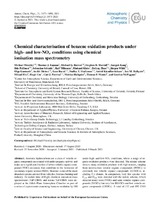Chemical characterisation of benzene oxidation products under high- And low-NOx conditions using chemical ionisation mass spectrometry
Abstract
Aromatic hydrocarbons are a class of volatile organic compounds associated with anthropogenic activity and make up a significant fraction of urban volatile organic compound (VOC) emissions that contribute to the formation of secondary organic aerosol (SOA). Benzene is one of the most abundant species emitted from vehicles, biomass burning and industry. An iodide time-of-flight chemical ionisation mass spectrometer (ToF-CIMS) and nitrate ToF-CIMS were deployed at the Jülich Plant Atmosphere Chamber as part of a series of experiments examining benzene oxidation by OH under high- and low-NOx conditions, where a range of organic oxidation products were detected. The nitrate scheme detects many oxidation products with high masses, ranging from intermediate volatile organic compounds (IVOCs) to extremely low volatile organic compounds (ELVOCs), including C12 dimers. In comparison, very few species with C≥6 and O≥8 were detected with the iodide scheme, which detected many more IVOCs and semi-volatile organic compounds (SVOCs) but very few ELVOCs and low volatile organic compounds (LVOCs). A total of 132 and 195 CHO and CHON oxidation products are detected by the iodide ToF-CIMS in the low- and high-NOx experiments respectively. Ring-breaking products make up the dominant fraction of detected signal and 21 and 26 of the products listed in the Master Chemical Mechanism (MCM) were detected. The time series of highly oxidised (O≥6) and ring-retaining oxidation products (C6 and double-bond equivalentD4) equilibrate quickly, characterised by a square form profile, compared to MCM and ring-breaking products which increase throughout oxidation, exhibiting sawtooth profiles. Under low-NOx conditions, all CHO formulae attributed to radical termination reactions of first-generation benzene products, and first-generation auto-oxidation products are observed.

